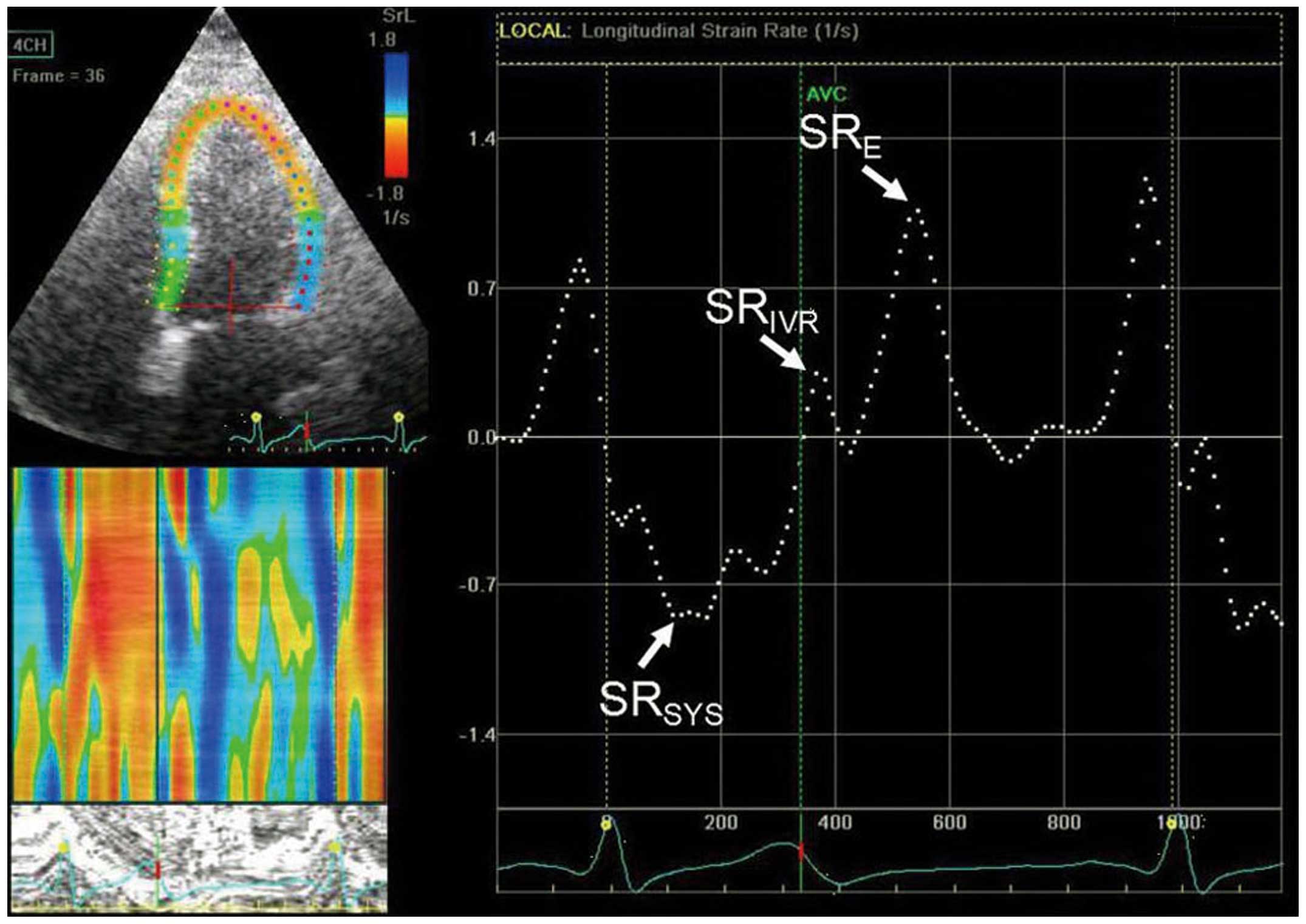|
1
|
McAlister FA, Ezekowitz J, Tonelli M and
Armstrong PW: Renal insufficiency and heart failure: prognostic and
therapeutic implications from a prospective cohort study.
Circulation. 109:1004–1009. 2004. View Article : Google Scholar : PubMed/NCBI
|
|
2
|
Nardi E, Cottone S, Mulè G, et al:
Influence of chronic renal insufficiency on left ventricular
diastolic function in hypertensives without left ventricular
hypertrophy. J Nephrol. 20:320–328. 2007.PubMed/NCBI
|
|
3
|
Bruch C, Rothenburger M, Gotzmann M, et
al: Chronic kidney disease in patients with chronic heart failure -
impact on intracardiac conduction, diastolic function and
prognosis. Int J Cardiol. 118:375–380. 2007. View Article : Google Scholar : PubMed/NCBI
|
|
4
|
Blood Pressure Lowering Treatment
Trialists' Collaboration, . Ninomiya T, Perkovic V, Turnbull F, et
al: Blood pressure lowering and major cardiovascular events in
people with and without chronic kidney disease: meta-analysis of
randomised controlled trials. BMJ. 347:f56802013. View Article : Google Scholar : PubMed/NCBI
|
|
5
|
Foley RN, Parfrey PS and Sarnak MJ:
Clinical epidemiology of cardiovascular disease in chronic renal
disease. Am J Kidney Dis. 32:(Suppl 3). S112–S119. 1998. View Article : Google Scholar : PubMed/NCBI
|
|
6
|
Fathi R, Isbel N, Haluska B, et al:
Correlates of subclinical left ventricular dysfunction in ESRD. Am
J Kidney Dis. 41:1016–1025. 2003. View Article : Google Scholar : PubMed/NCBI
|
|
7
|
Solomon SD, Janardhanan R, Verma A, et al:
Valsartan In Diastolic Dysfunction (VALIDD) Investigators: Effect
of angiotensin receptor blockade and antihypertensive drugs on
diastolic function in patients with hypertension and diastolic
dysfunction: a randomised trial. Lancet. 369:2079–2087. 2007.
View Article : Google Scholar : PubMed/NCBI
|
|
8
|
Heerspink HJ, Ninomiya T, Perkovic V, et
al: ADVANCE Collaborative Group: Effects of a fixed combination of
perindopril and indapamide in patients with type 2 diabetes and
chronic kidney disease. Eur Heart J. 31:2888–2896. 2010. View Article : Google Scholar : PubMed/NCBI
|
|
9
|
Wang J, Khoury DS, Thohan V, et al: Global
diastolic strain rate for the assessment of left ventricular
relaxation and filling pressures. Circulation. 115:1376–1383. 2007.
View Article : Google Scholar : PubMed/NCBI
|
|
10
|
Kasner M, Gaub R, Sinning D, et al: Global
strain rate imaging for the estimation of diastolic function in
HFNEF compared with pressure-volume loop analysis. Eur J
Echocardiogr. 11:743–751. 2010. View Article : Google Scholar : PubMed/NCBI
|
|
11
|
National Kidney Foundation, . K/DOQI
clinical practice guidelines for chronic kidney disease:
evaluation, classification and stratification. Am J Kidney Dis =
39. (Suppl 1). S1–S266. 2002.PubMed/NCBI
|
|
12
|
Lenfant C, Chobanian AV, Jones DW and
Roccella EJ: Joint National Committee on the Prevention, Detection,
Evaluation, and Treatment of High Blood Pressure: Seventh report of
the Joint National Committee on the Prevention, Detection,
Evaluation and Treatment of High Blood Pressure (JNC 7): resetting
the hypertension sails. Hypertension. 41:1178–1179. 2003.
View Article : Google Scholar : PubMed/NCBI
|
|
13
|
Ma YC, Zuo L, Chen JH, et al: Modified
glomerular filtration rate estimating equation for Chinese patients
with chronic kidney disease. J Am Soc Nephrol. 17:2937–2944. 2006.
View Article : Google Scholar : PubMed/NCBI
|
|
14
|
Lang RM, Bierig M, Devereux RB, et al:
Chamber Quantification Writing Group; American Society of
Echocardiography's Guidelines and Standards Committee; European
Association of Echocardiography: Recommendations for chamber
quantification: a report from the American Society of
Echocardiography's Guidelines and Standards Committee and the
Chamber Quantification Writing Group, developed in conjunction with
the European Association of Echocardiography, a branch of the
European Society of Cardiology. J Am Soc Echocardiogr.
18:1440–1463. 2005. View Article : Google Scholar : PubMed/NCBI
|
|
15
|
Alam M, Zhang L, Stampehl M, et al:
Usefulness of speckle tracking echocardiography in hypertensive
crisis and the effect of medical treatment. Am J Cardiol.
112:260–265. 2013. View Article : Google Scholar : PubMed/NCBI
|
|
16
|
Kimura K, Takenaka K, Ebihara A, et al:
Speckle tracking global strain rate E/E' predicts LV filling
pressure more accurately than traditional tissue Doppler E/E'.
Echocardiography. 29:404–410. 2012. View Article : Google Scholar : PubMed/NCBI
|
|
17
|
Andersen MJ, Ersbøll M, Gustafsson F, et
al: Exercise-induced changes in left ventricular filling pressure
after myocardial infarction assessed with simultaneous right heart
catheterization and Doppler echocardiography. Int J Cardiol.
168:2803–2810. 2013. View Article : Google Scholar : PubMed/NCBI
|
|
18
|
Paulus WJ, Tschöpe C, Sanderson JE, et al:
How to diagnose diastolic heart failure: a consensus statement on
the diagnosis of heart failure with normal left ventricular
ejection fraction by the Heart Failure and Echocardiography
Associations of the European Society of Cardiology. Eur Heart J.
28:2539–2550. 2007. View Article : Google Scholar : PubMed/NCBI
|
|
19
|
Tamez H, Zoccali C, Packham D, et al:
Vitamin D reduces left atrial volume in patients with left
ventricular hypertrophy and chronic kidney disease. Am Heart J.
164:902–909.e2. 2012. View Article : Google Scholar : PubMed/NCBI
|
|
20
|
Tapp RJ, Sharp A, Stanton AV, et al: ASCOT
Investigators: Differential effects of antihypertensive treatment
on left ventricular diastolic function: an ASCOT
(Anglo-Scandinavian Cardiac Outcomes Trial) substudy. J Am Coll
Cardiol. 55:1875–1881. 2010. View Article : Google Scholar : PubMed/NCBI
|
|
21
|
Aksoy H, Okutucu S, Kaya EB, et al:
Clinical and echocardiographic correlates of improvement in left
ventricular diastolic function after cardiac resynchronization
therapy. Europace. 12:1256–1261. 2010. View Article : Google Scholar : PubMed/NCBI
|
|
22
|
Van Schinkel LD, Auger D, van Elderen SG,
et al: Aortic stiffness is related to left ventricular diastolic
function in patients with diabetes mellitus type 1: assessment with
MRI and speckle tracking strain analysis. Int J Cardiovasc Imaging.
29:633–641. 2013. View Article : Google Scholar : PubMed/NCBI
|















